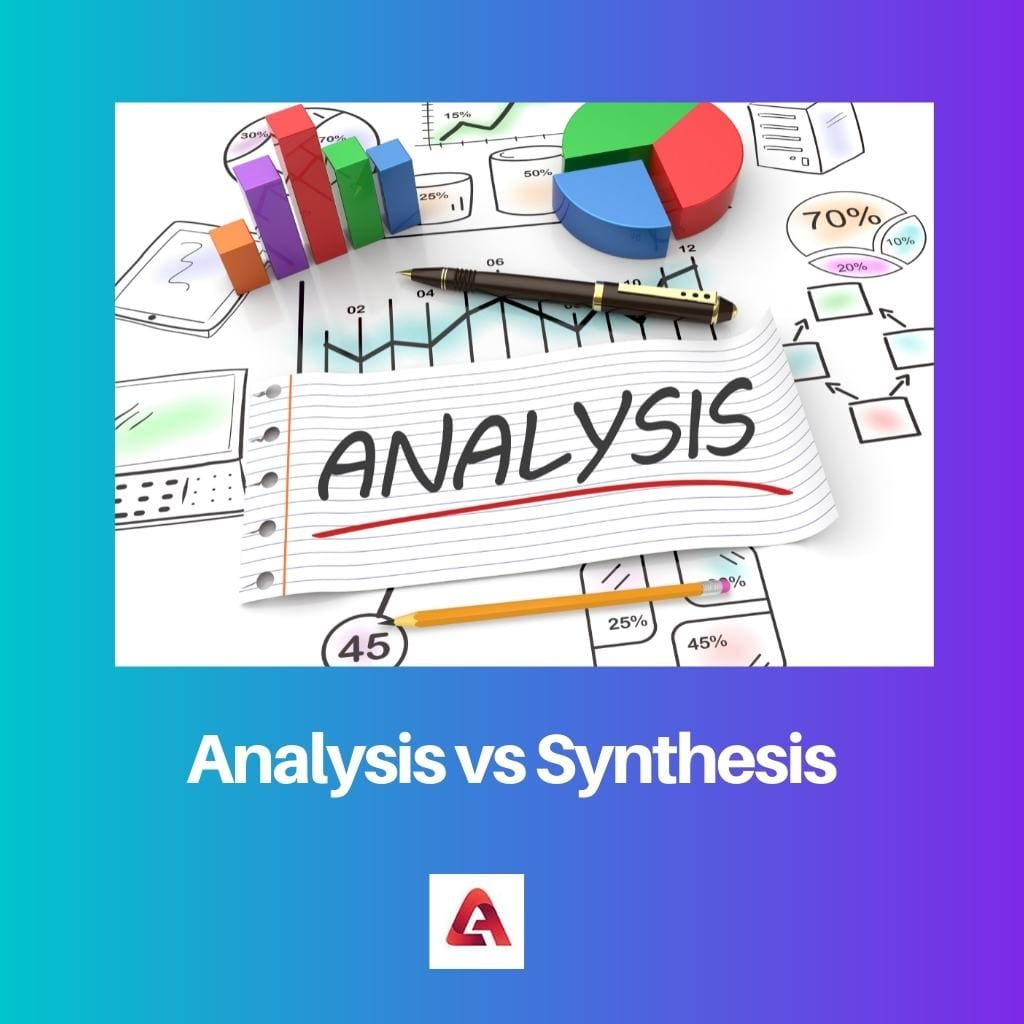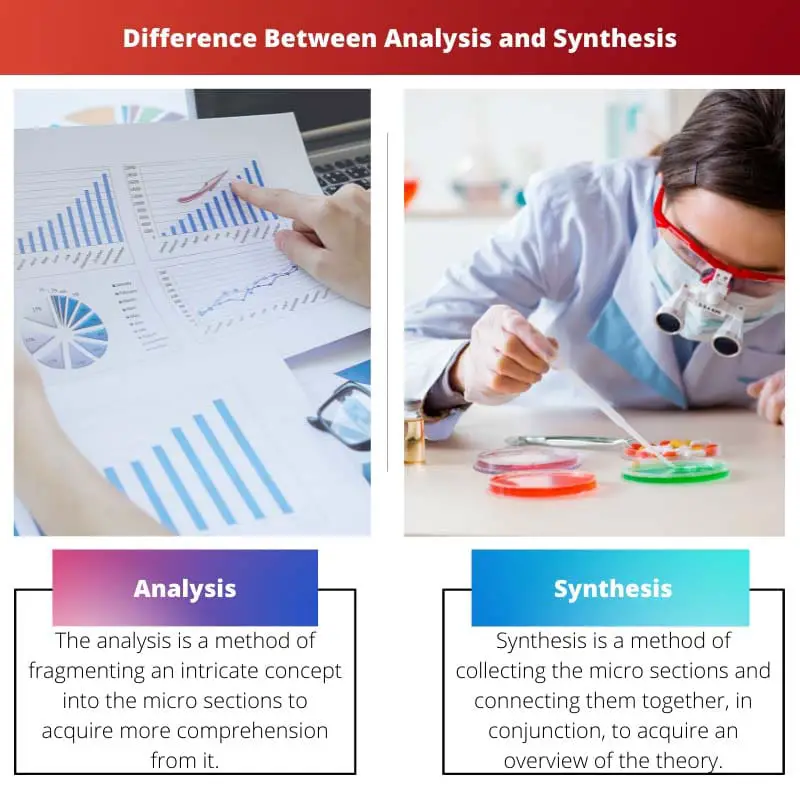Analysis involves breaking down complex concepts or systems into smaller components to understand their structure and function, while synthesis involves combining various elements or ideas to create something new or to form a cohesive whole. Analysis is akin to dissecting a puzzle to understand its individual pieces, while synthesis is like assembling those pieces to create a new picture or idea.
Key Takeaways
- An analysis examines and breaks down a complex idea or object into smaller parts to understand its structure and function.
- Synthesis combines multiple smaller ideas or parts to create a new and more complex idea or object.
- An analysis is a deductive process used to understand an object, while synthesis is an inductive process used to create a new object.
Analysis vs Synthesis
The difference Between Analysis and Synthesis is that they have different approaches. The analysis is a Micro approach, and the synthesis is a Macro.

The analysis involves disintegrating the fragments, whereas synthesis is an overview of the whole process. Analyzing is about observing and trying. Incidentally, synthesizing is experimenting and applying.
Comparison Table
| Feature | Analysis | Synthesis |
|---|---|---|
| Action | Breaks down | Builds up |
| Goal | Understand individual parts and their relationships | Create a new whole or understanding |
| Process | Breaks down information into smaller components, identifies patterns and relationships, interprets meaning | Combines information from various sources, identifies connections and patterns, creates new insights or interpretations |
| Output | Detailed findings, explanations, interpretations | New ideas, solutions, models, recommendations |
| Example | Analyzing a literary work to understand characters, themes, and literary devices | Synthesizing information from different research studies to draw new conclusions about a phenomenon |
What is Analysis?
Analysis is a systematic approach to understanding complex phenomena by breaking them down into smaller, more manageable components. It involves examining the elements, structure, and relationships within a system to gain insight, clarity, and comprehension.
Key Aspects of Analysis
- Decomposition: Analysis begins with decomposition, where the complex entity or problem is broken down into its constituent parts. This process involves identifying the fundamental components and understanding their individual characteristics and functions. For example, in the analysis of a literary text, decomposition might involve examining themes, characters, plot elements, and literary devices.
- Examination and Evaluation: Once the components are identified, analysis entails a thorough examination and evaluation of each element. This step involves scrutinizing the properties, behaviors, and interactions of the components to discern patterns, dependencies, and causal relationships. In scientific analysis, this might involve conducting experiments, gathering data, and applying statistical methods to draw conclusions.
- Interpretation and Synthesis: Analysis also encompasses interpretation, where the findings from the examination phase are synthesized to form a coherent understanding of the whole. This step involves making connections between the individual components, identifying overarching themes or principles, and drawing meaningful conclusions. Through interpretation, analysts derive insights and explanations that help illuminate the underlying mechanisms or dynamics of the system under study.
- Iterative Process: Analysis is an iterative process, where initial findings lead to further inquiry and refinement. Analysts may revisit earlier stages, gather additional data, or revise their interpretations in light of new evidence or insights. This iterative approach allows for a deepening understanding and refinement of the analysis over time.
Applications of Analysis
- Scientific Research: In scientific research, analysis is crucial for understanding natural phenomena, testing hypotheses, and advancing knowledge in various fields such as physics, biology, and psychology.
- Business and Management: Analysis plays a vital role in decision-making processes within organizations, where it is used to evaluate market trends, assess financial performance, and optimize operational strategies.
- Literary Criticism: Literary analysis involves dissecting literary works to uncover themes, symbolism, and narrative techniques, enabling scholars to interpret and appreciate literature on a deeper level.

What is Synthesis?
Synthesis is the process of combining separate elements or ideas to form a coherent whole that is greater than the sum of its parts. It involves integrating diverse components or perspectives to create something new, innovative, or harmonious.
Key Aspects of Synthesis
- Integration of Elements: Synthesis begins with the integration of disparate elements, whether they are ideas, materials, or concepts. This integration involves identifying connections, similarities, and complementary aspects among the individual components. By combining these elements, synthesis seeks to create a unified and cohesive structure or concept.
- Creativity and Innovation: Central to synthesis is the element of creativity, as it requires envisioning and generating novel solutions, designs, or interpretations. Synthesis involves thinking beyond conventional boundaries, exploring unconventional combinations, and generating original insights or perspectives. Through creative synthesis, individuals can produce innovative ideas, products, or artworks that transcend existing paradigms.
- Reconciliation of Differences: Synthesis also entails reconciling differences or contradictions between the components being combined. This may involve finding common ground, accommodating diverse viewpoints, or resolving conflicts to create a harmonious synthesis. By acknowledging and integrating diverse perspectives, synthesis can foster inclusivity, collaboration, and mutual understanding.
- Transformation and Emergence: In the process of synthesis, the combined elements undergo transformation, resulting in emergent properties or qualities that were not present in the individual components. This emergence gives rise to new patterns, meanings, or functionalities that enrich the synthesized whole. Through synthesis, disparate elements are reconfigured and elevated to create something that transcends their original forms.
Applications of Synthesis
- Innovation and Design: Synthesis is fundamental to the process of innovation and design, where it enables the creation of new products, technologies, or solutions by combining existing ideas, materials, or techniques in novel ways.
- Interdisciplinary Research: Synthesis plays a crucial role in interdisciplinary research, where it facilitates the integration of insights and methodologies from diverse fields to address complex problems or phenomena.
- Artistic Expression: In the arts, synthesis allows artists to blend various techniques, styles, or themes to create original artworks that express complex emotions, concepts, or narratives.

Main Differences Between Analysis and Synthesis
- Approach:
- Analysis involves breaking down complex phenomena into smaller components for examination.
- Synthesis involves combining separate elements or ideas to form a cohesive whole.
- Purpose:
- Analysis aims to understand the structure, function, and relationships within a system or concept.
- Synthesis aims to create something new, innovative, or integrated by combining diverse elements or perspectives.
- Outcome:
- Analysis results in a deeper understanding and clarification of the components and mechanisms of a system.
- Synthesis results in the emergence of novel ideas, solutions, or artworks that transcend the original components.
- Process:
- Analysis follows a systematic, step-by-step approach, involving decomposition, examination, and interpretation.
- Synthesis involves creative thinking, experimentation, and the reconciliation of disparate elements to generate innovative outcomes.
- Iterative Nature:
- Analysis can be iterative, with findings leading to further inquiry and refinement of understanding.
- Synthesis may also be iterative, as the process of combining elements involves experimentation and revision to achieve the desired outcome.

The comparison of the advantages and disadvantages of analysis and synthesis is thought-provoking. It highlights the intricacies of both methods.
Absolutely, the examination of advantages and disadvantages sheds light on the multifaceted nature of research methods.
I agree, William. The exploration of pros and cons provides a more nuanced perspective on the complexities of analysis and synthesis.
The correlation section about the relationship between analysis and synthesis is a crucial aspect to grasp. It sheds light on the interconnected nature of these research methods.
Absolutely, Cameron. Understanding the correlation between these processes is essential for a holistic approach to research.
I couldn’t agree more, Cameron. The interconnectedness of analysis and synthesis is a key takeaway from the article.
The article presents a thorough comparison of analysis and synthesis, but the disadvantages section for both methods could be more balanced with their advantages.
I see your point, Gmoore. A more balanced exploration of both pros and cons would provide a more nuanced understanding of the two processes.
I agree with Edavis. A balanced view of advantages and disadvantages would provide a more comprehensive perspective on analysis and synthesis.
The detailed explanation of the types and history of analysis and synthesis is fascinating. It adds depth to the understanding of these research methods.
I couldn’t agree more, Parker. The historical context provides a richer framework for understanding the evolution of these research methods.
The article is quite comprehensive, but I find it ironic that it’s easier to understand and execute analysis, yet it has its disadvantages of missing larger theories. It’s a paradox of sorts.
I hadn’t thought of it that way, Xallen. It’s an ironic observation that adds an intriguing layer to the discussion.
I see your point, Xallen. It is indeed an interesting paradox that highlights the complexities and trade-offs involved in research methods.
This article is a comprehensive guide for anyone conducting research. The clear distinction between analysis and synthesis is very informative and useful for those in a scientific field.
I completely agree. The in-depth explanation of the two processes is very valuable for those who need to understand them in a practical context.
A commendable article that provides a thorough understanding of the processes of analysis and synthesis. The comparison table is particularly helpful for clarity.
I appreciate the comparison table that clearly highlights the differences between analysis and synthesis. It helps to understand the concepts better.
Yes, the comparison table is a great addition to the article. It makes it easier to grasp the complexities of these research methods.
The article provides a solid foundation for understanding analysis and synthesis. It’s a great resource for anyone delving into these research methods.
The discussion of the impact, dependency, and methods applied in research for analysis and synthesis is very illuminating. It shows the depth of understanding required for these processes.
Absolutely, Tim. It’s essential to grasp these finer details to conduct effective research and draw meaningful conclusions.